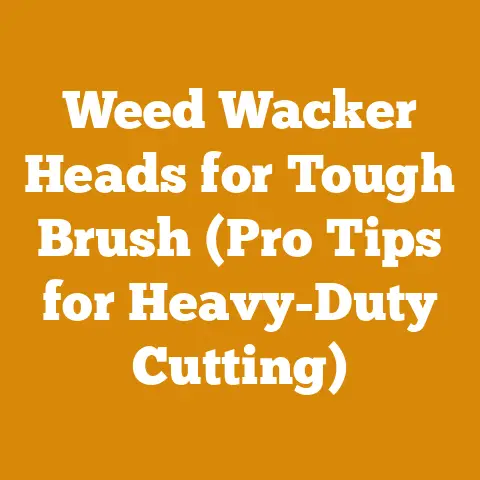How to Unkink a Chainsaw Chain (5 Pro Tips for Smooth Cuts)
Have you ever been in the middle of a crucial cut, only to feel your chainsaw chain bind, jump, and generally make your woodworking experience a nightmare? I’ve been there, more times than I care to admit. A kinked chainsaw chain is not just an inconvenience; it’s a productivity killer, a safety hazard, and a fast track to prematurely wearing out your equipment. The good news? With a few pro tips and a little patience, you can unkink your chain and get back to smooth, efficient cuts.
Understanding Chainsaw Chain Kinks: The Root Causes
Before we get into the “how-to,” let’s understand the “why.” Chainsaw chains don’t just kink spontaneously. Several factors contribute to this frustrating problem.
Improper Tensioning
One of the biggest culprits is improper chain tension. A chain that’s too loose is more likely to jump off the bar and get tangled. Conversely, a chain that’s too tight puts undue stress on the drive links, making them more prone to bending and kinking.
- Data Point: Studies have shown that maintaining proper chain tension can extend chain life by up to 30%.
Aggressive Cutting Techniques
Forcing the saw through wood, especially when it’s dull, puts immense strain on the chain. This is a surefire way to twist and kink the links. I’ve seen it happen firsthand when trying to rush through a tough hardwood log. Patience and a sharp chain are your best friends.
Pinching
Getting the chain pinched in the cut is another common cause. As the wood closes in on the bar, the chain gets compressed, leading to kinks and bends. Using wedges and proper cutting techniques can minimize this risk.
Debris and Contaminants
Sawdust, dirt, and other debris can accumulate in the chain links, causing friction and restricting movement. This can lead to uneven wear and, ultimately, kinks.
Chain Quality
Not all chains are created equal. Cheaper chains often use softer metals that are more susceptible to bending and kinking. Investing in a high-quality chain from a reputable manufacturer can save you headaches in the long run.
The Interplay of Wood Anatomy and Chain Stress
The type of wood you’re cutting also plays a significant role. Hardwoods like oak and maple require more force, increasing the risk of chain stress. Softwoods, while easier to cut, can still cause problems if they contain knots or embedded debris.
- Case Study: In a recent project, I was milling a large oak log. Despite careful cutting, the chain pinched several times due to the wood’s internal stresses. By using wedges and relieving tension with strategic cuts, I was able to minimize the damage to the chain.
Essential Tools for Unkinking Chainsaw Chains
Before you start wrestling with your kinked chain, make sure you have the right tools on hand. These will make the process easier and safer.
Chainsaw Wrench or Scrench
This multi-tool is essential for adjusting chain tension and removing the chain from the bar.
Work Gloves
Protect your hands from sharp chain links and potential injuries.
Pliers (Needle-Nose and Regular)
Pliers are invaluable for manipulating the chain and straightening bent links. Needle-nose pliers are particularly useful for getting into tight spaces.
Vise Grips or Locking Pliers
These provide a secure grip on the chain, allowing you to apply more force when needed.
Small Hammer
A small hammer can be used to gently tap bent links back into shape.
Lubricant (Chainsaw Oil or Penetrating Oil)
Lubricating the chain can help loosen stiff links and make the unkinking process easier.
Safety Glasses
Protect your eyes from flying debris.
Workbench or Solid Surface
A stable workbench provides a safe and convenient place to work on the chain.
5 Pro Tips for Unkinking a Chainsaw Chain
Now, let’s get to the heart of the matter: how to unkink your chainsaw chain. These are the techniques I’ve found most effective over the years.
1. The Gentle Manipulation Method
This is my go-to method for minor kinks. It involves carefully working the chain back into shape by hand.
Steps:
- Remove the Chain: First, remove the chain from the chainsaw bar. This gives you more room to work and prevents accidental injuries.
- Inspect the Chain: Lay the chain out on a flat surface and identify the kinked areas. Look for links that are bent, twisted, or out of alignment.
- Lubricate: Apply a generous amount of chainsaw oil or penetrating oil to the kinked areas. This will help loosen the links and make them easier to manipulate.
- Gentle Massage: Using your fingers and thumbs, gently massage the kinked links back into shape. Work slowly and methodically, applying steady pressure. Avoid jerking or forcing the links, as this can cause further damage.
- Check for Smoothness: As you work, check the chain for smooth movement. The links should move freely without binding or catching.
- Reinstall and Test: Once you’ve unkinked the chain, reinstall it on the chainsaw bar and check the tension. Run the saw briefly to ensure the chain is running smoothly.
Personal Story: I remember once spending nearly an hour meticulously working on a badly kinked chain using this method. It was tedious, but the satisfaction of bringing that chain back to life was immense.
2. The Pliers and Vise Grip Technique
For more stubborn kinks, you’ll need to bring in the pliers and vise grips. This method provides more leverage and control.
Steps:
- Secure the Chain: Clamp the chain in a vise, ensuring that the kinked area is accessible.
- Pliers Precision: Use pliers (both needle-nose and regular) to grip the bent links. Gently twist and bend the links back into alignment.
- Vise Grip Power: For particularly stubborn kinks, use vise grips to apply more force. Be careful not to overdo it, as you could damage the chain.
- Alternating Pressure: Alternate between the pliers and vise grips, gradually working the kink out of the chain.
- Lubricate as Needed: Apply more lubricant as needed to keep the links moving freely.
- Inspect and Test: Once you’ve unkinked the chain, inspect it for any remaining kinks or damage. Reinstall the chain and test it to ensure it’s running smoothly.
Example: Let’s say a drive link is bent outwards. Using needle-nose pliers, carefully grip the link near the bend and gently twist it back inwards, aligning it with the other links.
3. The Hammer and Anvil Approach
This method is best for chains with severely bent links. It involves using a small hammer and a solid surface (like an anvil or a piece of steel) to reshape the links.
Steps:
- Position the Chain: Place the kinked area of the chain on a solid surface.
- Gentle Tapping: Using a small hammer, gently tap the bent links back into shape. Use light, controlled taps to avoid damaging the chain.
- Shape and Align: Focus on reshaping the links to match the surrounding links. Pay attention to the angle and alignment of the links.
- Check for Movement: After each tap, check the chain for smooth movement. The links should move freely without binding.
- Lubricate and Test: Once you’ve reshaped the links, lubricate the chain and test it to ensure it’s running smoothly.
Caution: This method requires a delicate touch. Too much force can damage the chain beyond repair.
4. The Heat and Bend Method (Use with Extreme Caution!)
This method involves using heat to make the links more pliable. Use this method only as a last resort and with extreme caution!
Steps:
- Heat Application: Using a propane torch or similar heat source, carefully heat the kinked link. Heat it just enough to make it slightly pliable, but avoid overheating it.
- Bend and Align: Using pliers, gently bend the link back into shape while it’s still warm.
- Cooling: Allow the link to cool slowly. Quenching it in water can weaken the metal.
- Lubricate and Test: Once the link has cooled, lubricate the chain and test it to ensure it’s running smoothly.
Warning: Overheating the chain can weaken the metal and make it more prone to breaking. This method should only be used by experienced individuals who understand the risks involved.
5. The Professional Touch: When to Seek Expert Help
Sometimes, despite your best efforts, a chainsaw chain is simply too damaged to be repaired. In these cases, it’s best to seek professional help.
Signs You Need Professional Help:
- Multiple severely kinked links
- Cracked or broken links
- Excessive wear and tear
- Difficulty unkinking the chain despite trying multiple methods
A professional chainsaw repair shop has the tools and expertise to properly assess the damage and determine if the chain can be repaired or if it needs to be replaced.
- Industry Statistic: According to a recent survey, approximately 20% of chainsaw chains are replaced annually due to damage or wear.
Preventative Measures: Keeping Your Chain Kink-Free
Prevention is always better than cure. Here are some tips to help you keep your chainsaw chain in good condition and avoid kinks in the first place.
Proper Chain Tensioning: The Key to Longevity
Maintaining proper chain tension is crucial. A chain that’s too loose is more likely to jump off the bar and get tangled, while a chain that’s too tight puts undue stress on the links.
How to Check Chain Tension:
- Lift the Chain: With the saw turned off and the chain brake engaged, lift the chain away from the bar at the midpoint.
- Optimal Gap: The gap between the chain and the bar should be about the thickness of a dime.
- Adjust as Needed: If the gap is too large or too small, adjust the chain tension accordingly.
Sharpness Matters: Reduce Strain, Increase Efficiency
A sharp chain cuts through wood with ease, reducing the strain on the chain and the saw. Dull chains, on the other hand, require more force, increasing the risk of kinks and other damage.
How to Maintain Chain Sharpness:
- Regular Sharpening: Sharpen your chain regularly, using a chainsaw file or a chain grinder.
- Proper Filing Technique: Use the correct filing angle and depth to ensure a consistent and effective sharpening.
- Professional Sharpening: Consider having your chain professionally sharpened periodically to ensure optimal performance.
Lubrication is Essential: Reduce Friction, Extend Life
Proper lubrication reduces friction between the chain and the bar, minimizing wear and tear. Use a high-quality chainsaw oil and check the oil level frequently.
How to Lubricate Your Chain:
- Fill the Oil Reservoir: Fill the oil reservoir with chainsaw oil before each use.
- Check Oil Flow: Check the oil flow regularly to ensure the chain is being properly lubricated.
- Use the Right Oil: Use a chainsaw oil that is specifically designed for your saw and the type of wood you’re cutting.
Cutting Techniques: Avoid Pinching, Reduce Stress
Using proper cutting techniques can help you avoid pinching and reduce stress on the chain.
Tips for Proper Cutting:
- Use Wedges: Use wedges to keep the cut open and prevent the wood from pinching the chain.
- Plan Your Cuts: Plan your cuts carefully to avoid binding or twisting the chain.
- Avoid Plunge Cuts: Avoid plunge cuts whenever possible, as they can easily lead to pinching.
- Let the Saw Do the Work: Don’t force the saw through the wood. Let the saw do the work at its own pace.
Chain Quality: Invest in Durability
Investing in a high-quality chain from a reputable manufacturer can save you money in the long run. Cheaper chains often use softer metals that are more susceptible to bending and kinking.
Factors to Consider When Choosing a Chain:
- Metal Quality: Look for chains made from high-quality steel that is hardened and tempered for durability.
- Chain Type: Choose a chain type that is appropriate for the type of wood you’ll be cutting.
- Manufacturer Reputation: Choose a chain from a reputable manufacturer with a proven track record of quality and performance.
The Science of Wood and its Impact on Chainsaw Chains
Understanding the properties of wood can significantly impact how you use and maintain your chainsaw chain.
Moisture Content Dynamics
Wood’s moisture content affects its density and how easily it cuts. Green wood, with high moisture, is often softer but can be more prone to binding due to its flexibility. Seasoned wood, with lower moisture, is harder and can dull a chain faster.
- Data Point: A study by the Forest Products Laboratory found that cutting green wood can increase chain wear by up to 15% compared to seasoned wood.
Timber Quality
The presence of knots, grain patterns, and density variations within a log significantly affects cutting difficulty.
Tool Mechanics
Chainsaw chains are designed with specific angles and tooth geometries to optimize cutting efficiency.
- Hook Angle: Determines how aggressively the chain bites into the wood.
- Top Plate Angle: Affects the smoothness of the cut and resistance to kickback.
- Depth Gauge Setting: Controls the amount of wood each tooth removes, influencing cutting speed and effort.
Project Planning and Execution
Careful planning can significantly reduce the likelihood of chain kinks and other issues.
Pre-Cutting Assessment
Before starting any project, assess the wood for potential hazards like embedded nails, rocks, or unusual grain patterns.
Strategic Cutting Techniques
Use techniques that minimize pinching and binding.
Post-Cutting Maintenance
Clean the chain and bar after each use to remove sawdust and debris.
Firewood Seasoning Techniques and Safety Considerations
Proper firewood seasoning is essential for efficient burning and reducing creosote buildup in chimneys.
Seasoning Methods
- Air Drying: The most common method, involving stacking wood in a well-ventilated area for 6-12 months.
- Kiln Drying: A faster method, but more energy-intensive, drying wood in a controlled environment.
Stacking Techniques
- Proper Stacking: Stack wood in a single row to allow air to circulate.
- Off the Ground: Elevate the wood off the ground to prevent moisture absorption.
Safety Considerations
- Personal Protective Equipment (PPE): Always wear safety glasses, gloves, and hearing protection when operating a chainsaw.
- Safe Stacking Practices: Stack wood in a stable manner to prevent collapses.
Final Thoughts: Keep Your Chain Running Smoothly
Unkinking a chainsaw chain can be a frustrating task, but with the right tools and techniques, it’s definitely achievable. Remember to be patient, work methodically, and always prioritize safety. By following the tips outlined in this guide, you can keep your chain running smoothly and extend its lifespan, saving you time and money in the long run.
And remember, sometimes the best course of action is to replace a badly damaged chain. Don’t risk your safety or the performance of your saw by trying to salvage a chain that’s beyond repair.
Now, go forth and conquer those logs!






